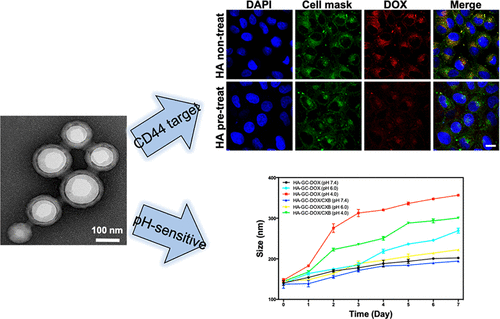当前位置:
X-MOL 学术
›
Bioconjugate Chem.
›
论文详情
Our official English website, www.x-mol.net, welcomes your
feedback! (Note: you will need to create a separate account there.)
Hyaluronic Acid-Decorated Glycol Chitosan Nanoparticles for pH-Sensitive Controlled Release of Doxorubicin and Celecoxib in Nonsmall Cell Lung Cancer.
Bioconjugate Chemistry ( IF 4.0 ) Pub Date : 2020-02-06 , DOI: 10.1021/acs.bioconjchem.0c00048 Ruda Lee 1 , Yu Jin Choi 2 , Myeong Seon Jeong 2 , Yong Il Park 3 , Keiichi Motoyama 4 , Min Woo Kim 1 , Seung-Hae Kwon 5 , Jung Hoon Choi 6
Bioconjugate Chemistry ( IF 4.0 ) Pub Date : 2020-02-06 , DOI: 10.1021/acs.bioconjchem.0c00048 Ruda Lee 1 , Yu Jin Choi 2 , Myeong Seon Jeong 2 , Yong Il Park 3 , Keiichi Motoyama 4 , Min Woo Kim 1 , Seung-Hae Kwon 5 , Jung Hoon Choi 6
Affiliation

|
Nonsmall cell lung cancer (NSCLC) is a leading cause of global cancer mortality. Recently, combinatorial treatment approaches have shown promise as they better address tumor heterogeneity. However, drug pharmacokinetics and tissue distribution differences remain problematic. To overcome these issues and improve therapeutic efficacies, the use of nanomedicines has been suggested. We devised a CD44 receptor target hyaluronic acid (HA)-decorated glycol chitosan (GC) nanoparticle which is conjugated to doxorubicin (DOX) by a pH-sensitive linker and coloaded celecoxib (CXB; HA-GC-DOX/CXB). Successful chemical conjugation of GC to DOX was confirmed and HA-GC-DOX/CXB showed ∼150 nm of uniform spherical shape. HA-GC-DOX/CXB were stable at pH 7.4 but steadily increased in size and released drugs at pH 6.0 and 4.0. In vitro NSCLC cells showed that DOX and CXB combination therapy has synergism in both free drug and nanoparticle formulation. In vivo NSCLC xenograft mice showed DOX and CXB exhibited a synergistic tumor suppressive effect in HA-GC-DOX/CXB. Furthermore, HA-GC-DOX/CXB dramatically inhibited tumor growth compared to other treatments as well as suppressed inflammation and metastasis-related gene/protein in the tumor tissues. Our findings demonstrate HA-GC-DOX/CXB is a potential anticancer therapy that controlled release under acidic tumor microenvironments and enhanced CD44 overexpressed tumor target efficacy.
中文翻译:

透明质酸修饰的乙二醇壳聚糖纳米颗粒用于非小细胞肺癌中pH敏感控制的阿霉素和塞来昔布的控释。
非小细胞肺癌(NSCLC)是全球癌症死亡率的主要原因。最近,组合治疗方法已显示出希望,因为它们可以更好地解决肿瘤的异质性。但是,药物的药代动力学和组织分布差异仍然存在问题。为了克服这些问题并提高治疗效果,已经建议使用纳米药物。我们设计了一种CD44受体靶透明质酸(HA)修饰的乙二醇壳聚糖(GC)纳米颗粒,该颗粒通过pH敏感的连接子与阿霉素(DOX)偶联,并共同装载了塞来昔布(CXB; HA-GC-DOX / CXB)。证实了GC与DOX的成功化学结合,并且HA-GC-DOX / CXB显示出约150 nm的均匀球形。HA-GC-DOX / CXB在pH 7.4时稳定,但尺寸稳定增加,在pH 6.0和4.0时释放药物。体外NSCLC细胞显示DOX和CXB联合疗法在游离药物和纳米颗粒制剂中均具有协同作用。体内NSCLC异种移植小鼠显示DOX和CXB在HA-GC-DOX / CXB中显示出协同的肿瘤抑制作用。此外,与其他治疗方法相比,HA-GC-DOX / CXB显着抑制了肿瘤的生长,并抑制了肿瘤组织中炎症和与转移相关的基因/蛋白质。我们的发现表明,HA-GC-DOX / CXB是一种潜在的抗癌疗法,可在酸性肿瘤微环境下控制释放,并增强CD44过表达的肿瘤靶标功效。与其他治疗方法相比,HA-GC-DOX / CXB显着抑制了肿瘤的生长,并抑制了肿瘤组织中与炎症和转移相关的基因/蛋白质。我们的发现表明,HA-GC-DOX / CXB是一种潜在的抗癌疗法,可在酸性肿瘤微环境下控制释放,并增强CD44过表达的肿瘤靶标功效。与其他治疗方法相比,HA-GC-DOX / CXB显着抑制了肿瘤的生长,并抑制了肿瘤组织中与炎症和转移相关的基因/蛋白质。我们的发现表明,HA-GC-DOX / CXB是一种潜在的抗癌疗法,可在酸性肿瘤微环境下控制释放,并增强CD44过表达的肿瘤靶标功效。
更新日期:2020-02-14
中文翻译:

透明质酸修饰的乙二醇壳聚糖纳米颗粒用于非小细胞肺癌中pH敏感控制的阿霉素和塞来昔布的控释。
非小细胞肺癌(NSCLC)是全球癌症死亡率的主要原因。最近,组合治疗方法已显示出希望,因为它们可以更好地解决肿瘤的异质性。但是,药物的药代动力学和组织分布差异仍然存在问题。为了克服这些问题并提高治疗效果,已经建议使用纳米药物。我们设计了一种CD44受体靶透明质酸(HA)修饰的乙二醇壳聚糖(GC)纳米颗粒,该颗粒通过pH敏感的连接子与阿霉素(DOX)偶联,并共同装载了塞来昔布(CXB; HA-GC-DOX / CXB)。证实了GC与DOX的成功化学结合,并且HA-GC-DOX / CXB显示出约150 nm的均匀球形。HA-GC-DOX / CXB在pH 7.4时稳定,但尺寸稳定增加,在pH 6.0和4.0时释放药物。体外NSCLC细胞显示DOX和CXB联合疗法在游离药物和纳米颗粒制剂中均具有协同作用。体内NSCLC异种移植小鼠显示DOX和CXB在HA-GC-DOX / CXB中显示出协同的肿瘤抑制作用。此外,与其他治疗方法相比,HA-GC-DOX / CXB显着抑制了肿瘤的生长,并抑制了肿瘤组织中炎症和与转移相关的基因/蛋白质。我们的发现表明,HA-GC-DOX / CXB是一种潜在的抗癌疗法,可在酸性肿瘤微环境下控制释放,并增强CD44过表达的肿瘤靶标功效。与其他治疗方法相比,HA-GC-DOX / CXB显着抑制了肿瘤的生长,并抑制了肿瘤组织中与炎症和转移相关的基因/蛋白质。我们的发现表明,HA-GC-DOX / CXB是一种潜在的抗癌疗法,可在酸性肿瘤微环境下控制释放,并增强CD44过表达的肿瘤靶标功效。与其他治疗方法相比,HA-GC-DOX / CXB显着抑制了肿瘤的生长,并抑制了肿瘤组织中与炎症和转移相关的基因/蛋白质。我们的发现表明,HA-GC-DOX / CXB是一种潜在的抗癌疗法,可在酸性肿瘤微环境下控制释放,并增强CD44过表达的肿瘤靶标功效。











































 京公网安备 11010802027423号
京公网安备 11010802027423号